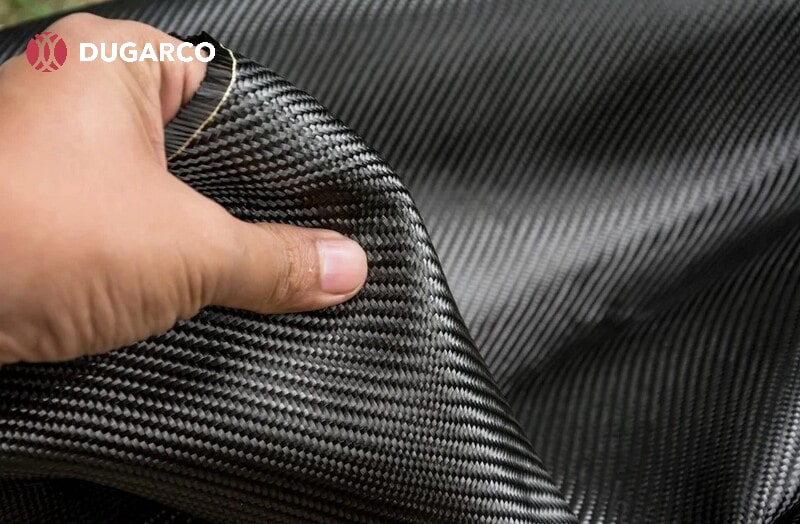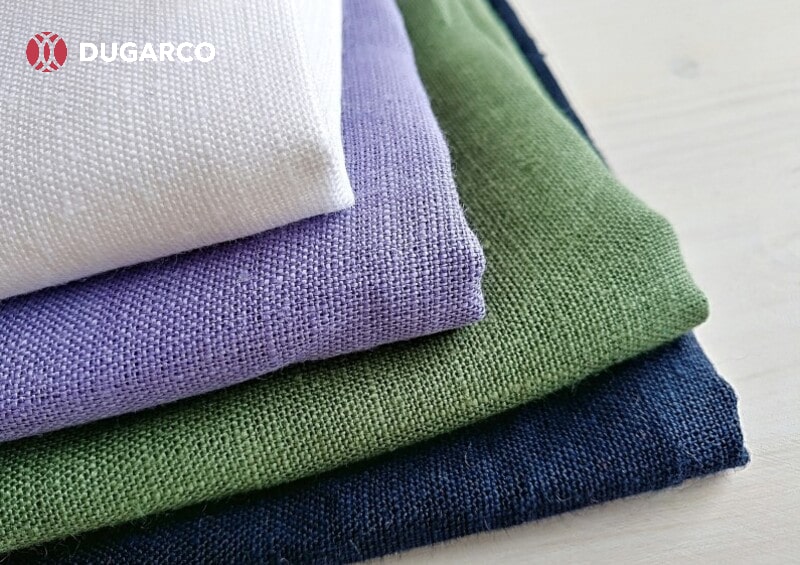Garment manufacturing is a complex process that involves many different stages. In it, raw materials for garment manufacturing play a very important role, which can have a significant impact on the final product. Let’s learn about the top 4 raw materials for apparel manufacturing with Dugarco.
>>>> CLICK HERE: 15 Eco friendly clothing materials for fashion sustainable
1. What are the main raw materials for making clothes?
Manufacturing raw materials are the primary substance which is utilized as input into a production process and then goes through many processing stages to finally be modified into a finished good. Raw materials may be in a processed or unprocessed state.

Raw materials for garment manufacturing are the foundational materials needed to create clothing products. The production of clothes and textiles begins with raw materials, which are then turned into finished goods through a variety of procedures like spinning, weaving, knitting, dyeing, and finishing. These materials can be natural or synthetic and can include:
- Fibre
- Yarn
- Fabric
- Dyes
- Chemicals and Auxiliaries
>>>> CLICK NOW: Top 10 best eco friendly garments, quality
2. Synthesize the needed raw materials for garment manufacturing
The manufacturing of clothing is a complicated process that uses a variety of raw materials. Each material plays a crucial role in the ultimate product’s quality and appearance. The following is the synthesis of the needed raw materials for garment manufacturing.
2.1. Fiber
Fibre is one of the most crucial components of manufacturing raw materials. Fibres can be derived from nature, including cotton, wool, silk, and linen, or synthetic which are manually produced, such as polyester, nylon, and acrylic. Depending on the required qualities of the garment, such as softness, durability, stretch, and moisture-wicking capabilities, the manufacturer should choose the appropriate fibre material.

>>>> MAYBE YOU NOT KNOW: Preferred fiber and materials market report 2023, trend 2024
2.2. Fabric
Fabrics are planar raw materials for making clothes structure, made by weaving together threads or filaments. The majority of fabrics are formed by knitting or weaving, although some are also made using non-woven techniques including twisting, felting, and braiding. Each garment’s fabric must be carefully chosen by the manufacturer, taking into account aspects like cost, availability, and environmental effect.

>>>> FIND OUT MORE:
- What is lyocell fabric? Advantages & disadvantages, application
- Linen Fabric For Clothing | Classification, advantages, application
- Everything you need to know about rayon fabric sustainable
2.3. Cotton
Cotton, which makes up more than a third of all raw material used in manufacturing, is the natural material that is most frequently used to manufacture apparel. It is utilized in lace, knit fabric, and woven cloth. Similar to how it is used to make hybrid textiles, it is blended with other fibres.

2.4. Nylon
Nylon has increasingly been popular in the garment manufacturing industry because of its durability, versatility, and hardness. Nylon is renowned for its durability, resistance to shrinking, and resistance to wrinkles, in addition to the characteristics of durability and ease of mass production at low cost. Therefore, nylon becomes a common and necessary material in everyday life.

However, nylon production can have negative environmental impacts, particularly in terms of energy consumption and greenhouse gas emissions. As such, it is important for garment manufacturers to weigh the benefits and drawbacks of using nylon and consider more sustainable alternatives.
2.5. Silk
Silk is one of the most pricey and highly desired raw materials for garment manufacturing. It is a natural fabric made by silkworms, thus bringing a silky, smooth feel and an attractive drape. Silk is renowned for being strong and long-lasting, making it the perfect fabric for high-end apparel. Besides frequently being linked with upscale fashion and formal settings, silk clothing may also be worn on a daily basis, bringing convenience to wearers every day.

2.6. Polyester
Polyester is a synthetic fabric that is frequently used in the production of clothing. It is renowned for its affordability, resistance to wrinkles, and durability. Polyester clothing is simple to maintain and can be washed and dried in a machine without shrinking or losing its form.

They are also perfect for sporting and outdoor clothes since they are lightweight and quick to dry. Polyester can be blended with other fibres, such as cotton or wool, to create fabrics that combine the best properties of each material.
2.7. Flax
The production of clothing has long utilized the natural fabric flax. It is made from the flax plant’s stem and is renowned for its toughness, tenacity, and breathability. Bed sheets, tablecloths, and napkins have all historically been made of linen due to their strength. Additionally, it has gained popularity in the world of fashion, particularly for summery garments like dresses, shirts, and pants.

2.8. Wool
Wool is a natural fibre that comes from the fleece of sheep and other animals such as goats, alpacas, and llamas. It is one of the most popular raw materials in garment factory because of its warmth, softness, and durability. Wool clothes are excellent for cold weather because wool fibres are naturally crimped, which helps them retain air and generate insulation. Wool also naturally wicks away moisture, thus allowing wearers to sweat without feeling damp or unpleasant.

>>>> FIND OUT MORE: Cellulose material – Advantages, applications & production
2.9. Dye stuff
Dyestuffs are a crucial part of the garment production process since they are used to provide textiles and garments with colour and aesthetic appeal. The dye is often applied in an aqueous solution, and a mordant is used to increase the dye’s fastness on the fibre. The following dyes are used:
- Reactive dye
- Disperse dye
- Acid dye
- Basic dye

- Direct dye
- Sulfur dye
- Azoic dye
- Vat dye
2.10. Chemical and auxiliaries
Chemicals and auxiliaries are raw materials for garment manufacturing that are frequently utilized in the clothing production industry. These components are used to give clothing additional colour, texture, and other aesthetic qualities. While some compounds may be helpful in obtaining desired outcomes, their usage might have detrimental effects on the environment and people’s health.

3. Synthetic vs. natural materials sources
Raw materials may be derived from synthetic or natural sources. Since each variety is produced differently, the textile industry uses them in various ways. Natural sources are defined as substances or materials that originate in natural settings such as forests, water bodies, minerals, or productive land and then are subsequently extracted by people undergoing many processing stages.

Synthetic materials are raw materials for garment manufacturing that are processed through a variety of techniques and machines created by humans, and then widely applied in the garment industry.
4. The importance of raw materials for garments production
Raw materials are the foundation of garment production, which represent about 50 to 70% of the production cost of a short-staple yarn. Choosing the right raw materials is essential for creating garments that are comfortable, durable, and visually appealing.

From 60 to 70 per cent of the entire cost of constructing a garment goes into the purchase of raw materials, which is the primary cost component. Therefore, the selection of raw materials can also affect the cost impact of garment production. Therefore, it is clear how important raw materials are to the textile and garment industries.
There is no denying the importance of raw materials for garment manufacturing. Please don’t hesitate to contact Dugarco for detailed advice if you have any queries or would want to know more about this production process.
Contact information:
- Address: 59 Đức Giang, Đức Giang, Long Biên, HN
- Phone: 024 3655 7930
- Email: dugarco@mayducgiang.com.vn
- Website: https://dugarco.com/en/
>>>> RELATED POST:
- Eco-friendly bamboo fabric clothing | Features & price
- What is Hemp Fabric? Salient features and applications

Dugarco under the talented leadership and guidance of Mr. Hoang Ve Dung has gradually become a large Vietnam clothing manufacturer, supplying clothes for many famous brands from many different countries such as the UK, USA, and Australia.






2 Responses
What is basic material required for garment manufacturing?
The basic materials required for garment manufacturing include both raw materials for fabric production and additional components for constructing and finishing garments like fabric, trims and accessories, dyes and chemicals, padding and insulation, packaging materials, garment patterns, and lining fabric,…